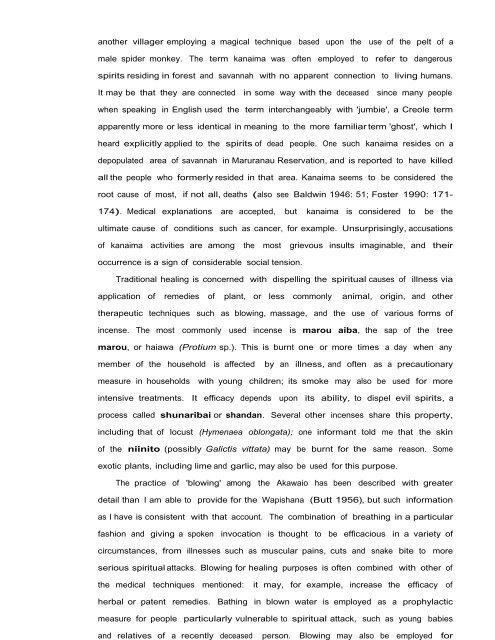Ethnoecology, Resource Use, Conservation And Development In A ...
Ethnoecology, Resource Use, Conservation And Development In A ...
Ethnoecology, Resource Use, Conservation And Development In A ...
You also want an ePaper? Increase the reach of your titles
YUMPU automatically turns print PDFs into web optimized ePapers that Google loves.
another villager employing a magical technique based upon the use of the pelt of a<br />
male spider monkey. The term kanaima was often employed to refer to dangerous<br />
spirits residing in forest and savannah with no apparent connection to living humans.<br />
It may be that they are connected in some way with the deceased since many people<br />
when speaking in English used the term interchangeably with 'jumbie', a Creole term<br />
apparently more or less identical in meaning to the more familiar term 'ghost', which I<br />
heard explicitly applied to the spirits of dead people. One such kanaima resides on a<br />
depopulated area of savannah in Maruranau Reservation, and is reported to have killed<br />
all the people who formerly resided in that area. Kanaima seems to be considered the<br />
root cause of most, if not all, deaths (also see Baldwin 1946: 51; Foster 1990: 171-<br />
174). Medical explanations are accepted, but kanaima is considered to be the<br />
ultimate cause of conditions such as cancer, for example. Unsurprisingly, accusations<br />
of kanaima activities are among the most grievous insults imaginable, and their<br />
occurrence is a sign of considerable social tension.<br />
Traditional healing is concerned with dispelling the spiritual causes of illness via<br />
application of remedies of plant, or less commonly animal, origin, and other<br />
therapeutic techniques such as blowing, massage, and the use of various forms of<br />
incense. The most commonly used incense is marou aiba, the sap of the tree<br />
marou, or haiawa (Protium sp.). This is burnt one or more times a day when any<br />
member of the household is affected by an illness, and often as a precautionary<br />
measure in households with young children; its smoke may also be used for more<br />
intensive treatments. It efficacy depends upon its ability, to dispel evil spirits, a<br />
process called shunaribai or shandan. Several other incenses share this property,<br />
including that of locust (Hymenaea oblongata); one informant told me that the skin<br />
of the niinito (possibly Galictis vittata) may be burnt for the same reason. Some<br />
exotic plants, including lime and garlic, may also be used for this purpose.<br />
The practice of 'blowing' among the Akawaio has been described with greater<br />
detail than I am able to provide for the Wapishana (Butt 1956), but such information<br />
as I have is consistent with that account. The combination of breathing in a particular<br />
fashion and giving a spoken invocation is thought to be efficacious in a variety of<br />
circumstances, from illnesses such as muscular pains, cuts and snake bite to more<br />
serious spiritual attacks. Blowing for healing purposes is often combined with other of<br />
the medical techniques mentioned: it may, for example, increase the efficacy of<br />
herbal or patent remedies. Bathing in blown water is employed as a prophylactic<br />
measure for people particularly vulnerable to spiritual attack, such as young babies<br />
and relatives of a recently deceased person. Blowing may also be employed for


